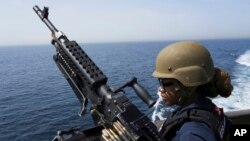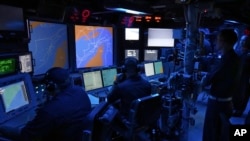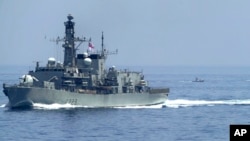The Mideast-based commanders of the U.S., British and French navies transited the Strait of Hormuz on Friday aboard an American warship, a sign of their unified approach to keep the crucial waterway open after Iran seized two oil tankers.
Tensions in the Persian Gulf have been volatile since Iran's nuclear deal with world powers collapsed, following the U.S.' unilateral withdrawal five years ago. The incredibly rare, joint trip by the three navy chiefs aboard the USS Paul Hamilton, an Arleigh Burke-class destroyer, saw three fast boats of the Iranian Revolutionary Guard approach the vessel at one point.
Guardsmen stood by uncovered machine guns on their decks, while sailors aboard the Paul Hamilton similarly stood by loaded machine guns as others shot photographs and video of the vessels. A journalist with The Associated Press accompanied the allied naval commanders.
While the Guard kept its distance from both the Paul Hamilton and the passing British frigate HMS Lancaster, their presence showed just how tense passage for vessels can be in the Strait of Hormuz, the narrow mouth of the Persian Gulf through which a fifth of global oil supplies passes.
“Iran has seized or attacked 15 ships in the last two years. Eight seizures and seven attacks," Vice Adm. Brad Cooper, who oversees the U.S. Navy's Mideast-based 5th Fleet, told the AP. "So the shipping industry is mindful of what the security posture looks like in the region. We have the ability to positively impact that influence and that’s what we’re doing now.”
Cooper said Iran's Guard ships Friday came within 915 meters of the Paul Hamilton, which is based out of San Diego.
The U.S. has viewed securing the Middle East's waterways, particularly the Strait of Hormuz, as key since then-President Jimmy Carter's 1980 speech vowing to use military force to protect American interests in the wider Persian Gulf. While focused then on the Soviet Union's invasion of Afghanistan, the Carter Doctrine's vow to allow “the free movement of Middle East oil” now pits the U.S. against Iran, which has seized a series of oil tankers since the collapse of its nuclear deal with world powers.
Last week, White House National Security Council spokesman John Kirby told journalists that America planned to make “a series of moves to bolster our defensive posture” in the Persian Gulf, while criticizing Iran's recent seizures of tankers. Cooper said the joint trip on the Paul Hamilton represented part of that push, with the aim of having more coalition ships passing through the strait on a regular basis.
"The volume of commerce that flows through the Strait of Hormuz — it is critical to the world’s economy,” he said.
For its part, Iran long has bristled at the American presence in the region. After Kirby's remarks, Iranian Foreign Ministry spokesman Nasser Kanaani issued a lengthy statement accusing the U.S. of “creating and intensifying instability and insecurity in the Persian Gulf region for decades with its interventionist and destructive policies.”
There was no immediate reaction in Iranian state media nor from the Guard about the Paul Hamilton's trip from the Persian Gulf out through the strait to the Gulf of Oman. However, it was unlikely the Iranians immediately knew that the American, British and French commanders had been aboard the vessel, though at least one Guard member aboard the fast boats was studying the Paul Hamilton with a pair of binoculars.
On the trip through the Strait of Hormuz, at least one Iranian drone watched the Paul Hamilton. Meanwhile, a U.S. Navy Boeing P-8 Poseidon also was overhead. U.S. forces also routinely fly drones in the region as well, while a Navy task force also has put some drones out to sea.
Securing the Strait of Hormuz has been a challenge since the Carter Doctrine — and deadly. The so-called 1980s “Tanker War” involved American naval ships escorting reflagged Kuwaiti oil tankers through the gulf and the strait after Iranian mines damaged vessels in the region. The U.S. Navy even fought a one-day naval battle against Iran at the time, as well as accidentally shot down an Iranian commercial airliner, killing 290 people.
Former President Donald Trump's decision to unilaterally withdraw from Tehran's nuclear deal with world powers sparked new challenges from Iran in the region. Tehran seized tankers, while the Navy also blamed Iran for again using mines against shipping. The Trump administration came up with its Sentinel program, which also involved it and partner nations escorting ships in the region. But tensions with Europe after the nuclear deal's collapse didn't see a wide buy-in with the program.
This renewed effort under President Joe Biden does not appear to involve escorting individual ships but trying to put more allied forces in the region. Already, the U.S. has brought A-10 Thunderbolt IIs and a submarine in the region to try to deter Iran.
America also could bring more ships into the Persian Gulf. The end of the wars in Afghanistan and Iraq, as well as the war in Ukraine and American concern over China's expansion in the South China Sea, has halted routine carrier deployments in recent years.
For now, Cooper pointed to the presence of his British and French colleagues — Commodore Philip Dennis, the commander of the United Kingdom Maritime Component Command, and Vice Adm. Emmanuel Slaars, the joint commander of the French forces deployed in the Indian Ocean — as a sign of the resolve of America and its partners.







